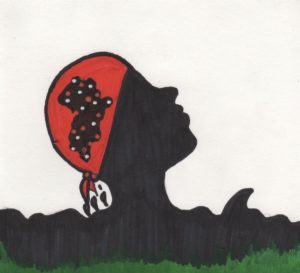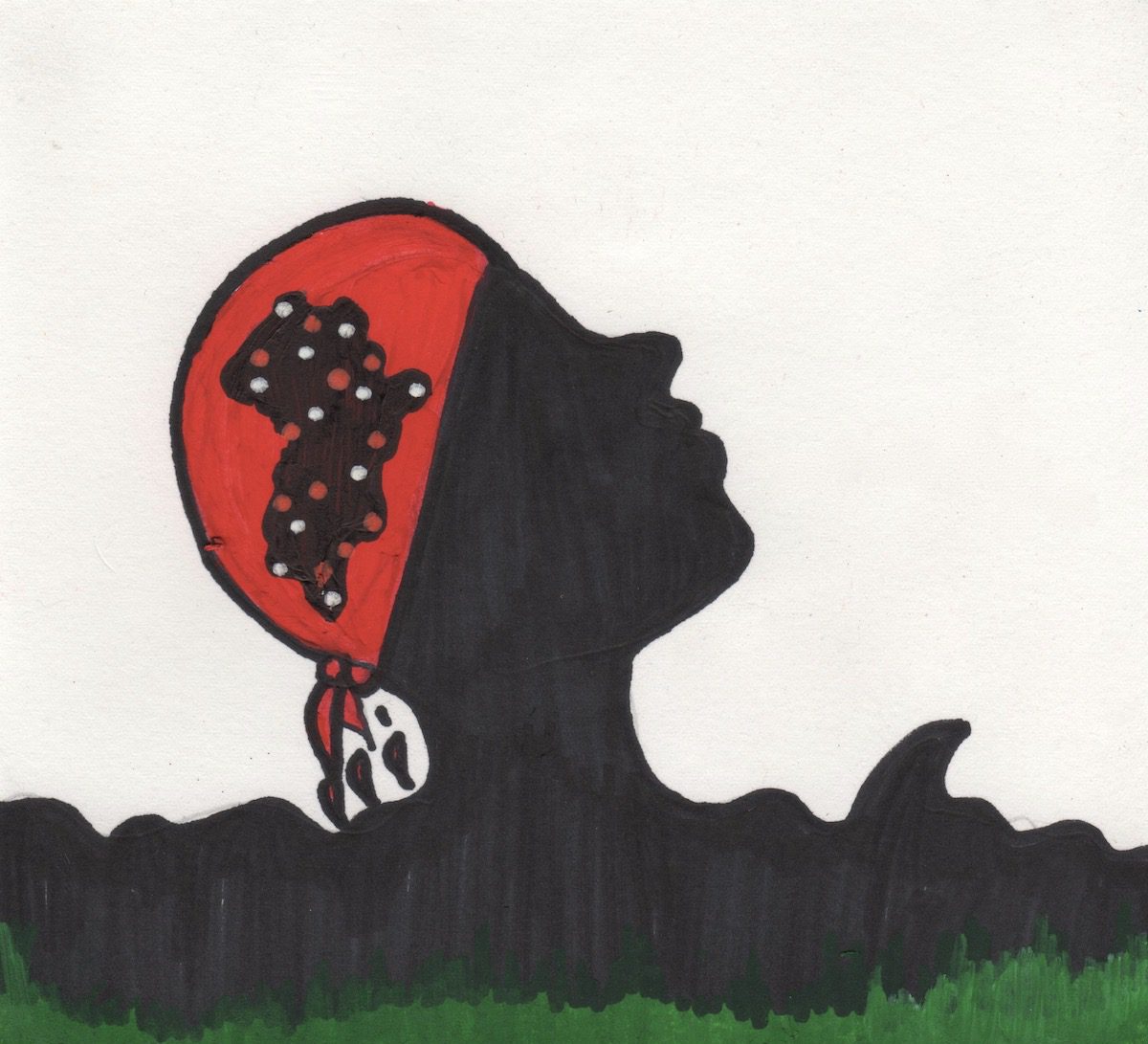
George Washington isn’t wearing a durag. This is my first thought when I pick up the quarter off the sidewalk on my way back from taking out the trash. I brought it close to my face, and the sun glinted off the copper-nickel, kissing George Washington’s Roman nose. His colonial wig, worn to make men appear older and distinguish classes, resembled, in that moment, a durag. The curls in the back cascaded like a braided tail flowing down his neck. Underneath the wig I imagined his real hair was rippling into presidential waves. Or maybe not. I’ll have to consult a scholar about that. But I think durag because, well, I’ve seen plenty in my life. And the guy who just bounced by my apartment building yelling out the rap lyrics, “I’ma takeoff / Ballin like Mike in the playoffs,” was rocking one. A striking Caribbean blue durag, its tail fluttering like a silk wing in the wind. He wears it like a crown. Gesturing his hands like he’s in a music video. I’ve never worn a durag myself. Never will. My hair is thinning. My Pops, on the other hand, used to stretch women’s stockings on his head as an alternative. He’d wear them to bed. In the morning I’d be cheffing up some cereal as he’d unveil freshly paved hair that would be flat as the Midwest plains. I preferred my hair, when I had a good amount, somewhat wavy. Strapped with a brush like a sidearm, rippling swells formed on the top of my head; I could never build currents all around my dome that way. No 360 waves like most of my friends who wore durags religiously. I could’ve probably benefited from one, but didn’t want to be caught with one on. Ever since rappers introduced durags to the rest of the world, they’ve become associated with criminal life. Labeling every durag-rocking Black boy as a thug. But we don’t want to be thugs. We just want to look good. We want to look like 50 Cent, who powerfully donned one on his Get Rich or Die Tryin’ album cover. Or like Camron, one of my favorite rappers, who wore one under a pink bucket hat while he recorded one of the greatest freestyles on the BET show, Rap City: Tha Basement. In 2019, Emmell Summerville, an eleven-year-old at a Catholic school in Canada was told to remove his durag. The principal believed it was gang-related. Several school districts in the US have banned them, sparking student protests. Black male students who wore durags at KIPP Academy Lynn Collegiate School were issued in-school suspensions. The school says they are a gateway to jail and gangbanging. On TikTok, Cameron Welch, age eighteen, fires off a litany of commandments, unwritten rules his mother claims young Black men should obey. One being, “Don’t drive with a durag on,” for fear, I’d imagine, of being pulled over. One summer night in 2010 I was pulled over anyway after leaving a Shell gas station. The cops said they got a call that a Black male was being suspicious out front. I told them I had bought a Mango Arizona Iced Tea with my friend and left. They didn’t care. They needed to search the car. I said I had nothing. “We’ll see,” they said. I had to clean up their mess after they tossed my Ford Focus. I wasn’t wearing a durag. Celebrities and some public figures have tried to destigmatize the durag. Solange Knowles rocked a black durag with a halo at the Met Gala. The theme, Catholicism. Written on its hem in Gothic font, “MY GOD WEARS A DURAG.” Recently, rapper Guapdad 4000, who once scammed Drake out of $100,000, attended the 2020 Grammys wearing a brilliant silver, ten-foot long durag. An interviewer on the red carpet, referencing the durag, said, “The drip is real.” In 1979, the same year Ugandan dictator Idi Amin was overthrown, durags created by William J. Dowdy hit shelves. They were designed to keep hair from frizzing and sticking up after brushing. When one removes their durag a precise assortment of waves wheel around your head. It should look like someone could surf in your joint. The waves should appear to be dripping. Make someone seasick. After Japanese naval fire severely hit the USS Gregory on September 5, 1942, Charles Jackson French swam eight hours through the night tugging a life raft of fifteen wounded white soldiers. With a rope tied around his waist, he treaded through shark-infested waters to safety on the Solomon Islands. French was awarded the Navy Medal in 1943. Tice Davids, a runaway slave from Kentucky, in 1831, dove into the Ohio River as his owner pursued him in a boat. Tice swam for his life across the great river. Then he disappeared. His owner, quoted in a local newspaper, reportedly said that Tice must have reached his destination via “an underground railroad.” He assumed Tice had drowned. Tice made it to Ripley, Ohio. He swam to his eventual freedom. I can picture Tice now. Slipping out of the water, sprinting north. His hair soaked, glistening. Free. The application of hair products dates back to slavery. The women, without traditional mixtures or proper herbal treatments from Africa, used bacon grease and, later, petroleum jelly on their scalps to help moisturize their beautiful wool-like hair. During the time of the Emancipation Proclamation, Vaseline, made from petroleum jelly, was created by Robert Chesebrough. Chesebrough, while visiting the oil fields in Titusville, Pennsylvania, stumbled upon “rod wax.” It was being used by the oil workers to heal minor cuts and abrasions. In 1905, Sarah Breedlove, a free-born daughter to slaves, produced her own pomade, a hair product for Black women which was made from petroleum jelly and sulfur. Breedlove would later change her name to Madam C. J. Walker, in honor of her late husband. She would become the first self-made woman millionaire in America. The word “pomade,” derived from the French “pommade” meaning “ointment,” has undergone many changes since the nineteenth century when bear fat was its main ingredient. Hair products have since graduated from using petroleum to other oils such as coconut and argan oil. I used to watch my friend’s sisters do hair out on the stoops of their apartments. They’d be out there all day braiding the hair of other young girls. Creating masterpieces on their heads. Splashing hair grease on shining scalps. Several of my friends would apply pomade to the bristles of their brushes. Petroleum jelly’s main ingredient is petrolatum, a chemical acquired from crude oil. Since 1958, 1.5 million tons of crude oil have spilled into the Niger River Delta. Shell, who in 2015 paid Nigeria $84 million for damages, among many other companies, leads the way in spills. I counted fifty-plus spills on a map of Nigeria’s polluted delta before I stopped counting. The gold dots on the map represent Shell, and countless yellow blemishes are scarred over the basin. The basin ranks as one of the most polluted on earth. The soil of the delta is black. Hardly anything can grow. It’s desolate, murky. A waste land. Clean drinking water is scarce. The oil has killed marine life. Fishing boats are locked in mud like tombstones. While Shell and other oil companies rake in billions from Nigeria’s lucrative oil industry, the locals struggle to survive on dollar-a-day wages. I’ve seen the clips of unemployed young men, who look like me, digging into the ground, scooping out pools of black liquid, burning it. Selling self-produced, self-refined diesel fuel to feed their families. Makeshift refineries have popped up around abandoned pipelines. The local government is tasked with destroying a village’s “illegal” supply. Slashing bags of fuel, dumping barrels back into waterways just yards from homes. “This illegal production is not good for the environment,” an official says in a clip, while a surge of diesel fuel rushes past his boots. It’s soaked into the soil. Slithers back into a lake. Locals who have managed to catch the tiny amount of fish still living say that when they eat what they catch, it causes a burning sensation in the body. In the same rivers and waterways, women and children are still washing their clothes. Cleaning their hands. Somehow, these images ashamedly remind me of this picture of my infant self. In the photo, my mother is bathing me in the kitchen sink. My calm eyes are gazing back at hers. The faucet spews a clear waterfall behind my little head. My brown skin is glowing. Curly locks are oil-black. Like a wet halo. My mother’s safe hands cradle my crown. Her fingers gently guide water through my hair.
***
Rumpus original art by Leesa Travis.





